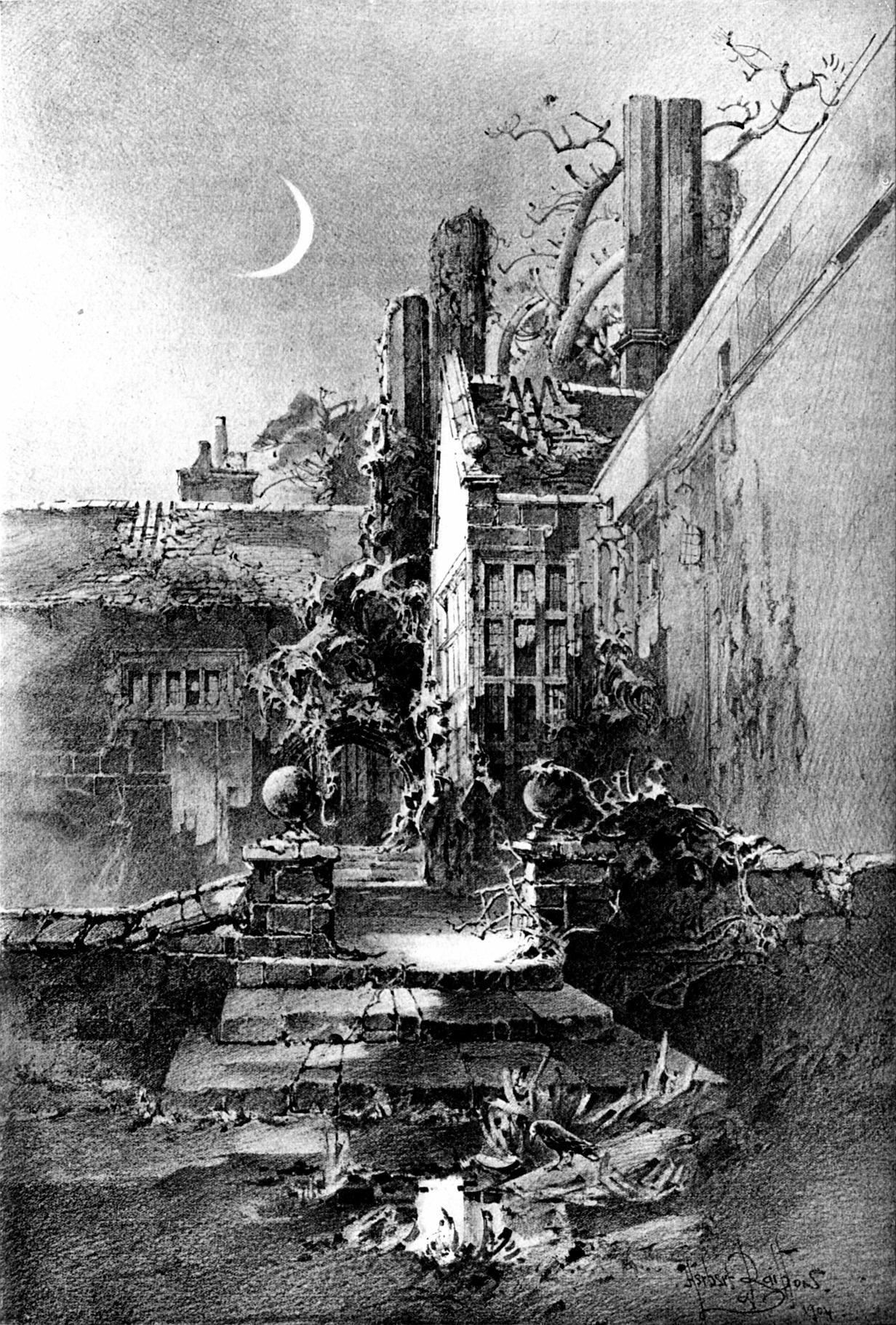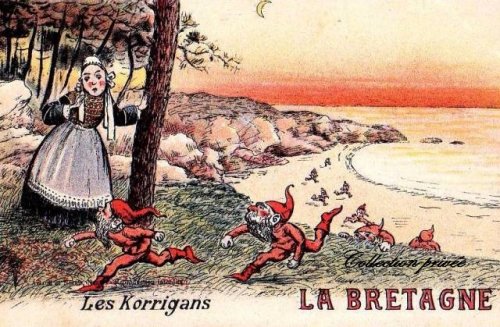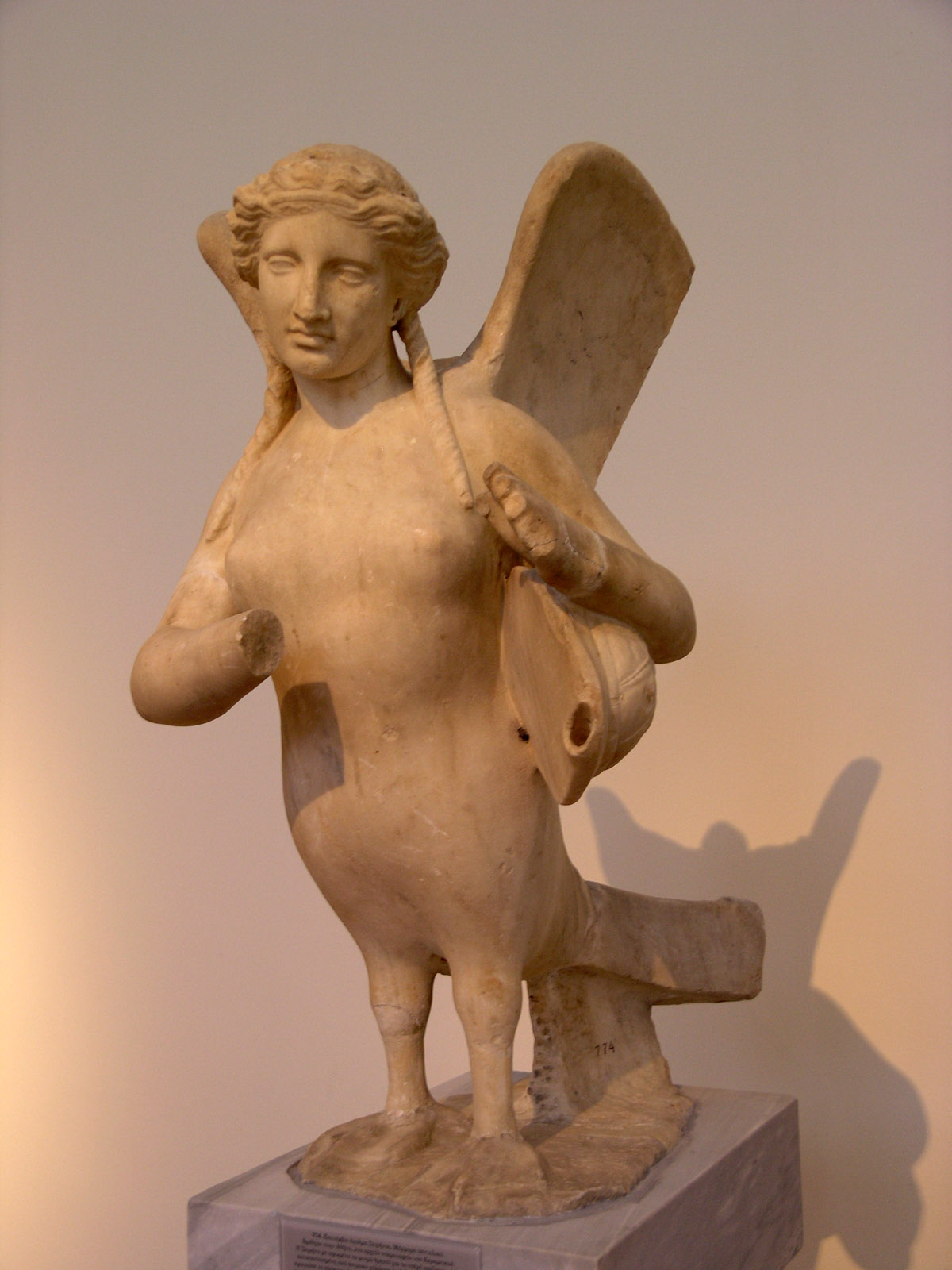|
Groac'h
A ' ( Breton for "fairy", "witch" or " crone", pl. ') is a kind of Breton water-fairy. Seen in various forms, often by night, many are old, similar to ogres and witches, sometimes with walrus teeth. Supposed to live in caverns, under the beach and under the sea, the ' has power over the forces of nature and can change its shape. It is mainly known as a malevolent figure, largely because of Émile Souvestre's story '' La Groac'h de l'île du Lok'', in which the fairy seduces men, changes them into fish and serves them as meals to her guests, on one of the Glénan Islands. Other tales present them as old solitary fairies who can overwhelm with gifts the humans who visit them. Several place-names of Lower Brittany are connected with the ', especially the names of some megaliths in Côtes-d'Armor, as well as the island of Groix in Morbihan and the lighthouse of La Vieille. The origin of those fairies that belong to the archetype of "the crone" is to be found in the ancient fem ... [...More Info...] [...Related Items...] OR: [Wikipedia] [Google] [Baidu] |
The Groac'h Of The Isle Of Lok
The Groac'h of the Isle of Lok ( French: ''La Groac’h de l’Île du Lok'')Souvestre, Émile; de la Barre, Ernest du Laurens; Luzel, François-Marie. Contes et légendes de Basse-Bretagne'. Société des bibliophiles bretons, 1891. pp. 3-24. is a Breton fairy tale collected by Émile Souvestre in ''Le Foyer breton''. Andrew Lang included it in ''The Lilac Fairy Book'', and Ruth Manning-Sanders included it in '' A Book of Mermaids''. Synopsis Two cousins, a young man named Houarn Pogamm and a girl called Bellah Postik, grew up together, and their mothers thought they would marry, but when they came of age, their mothers died. Being penniless, Houarn and Bellah both had to become servants. They lamented their poverty, dreaming of a little farm where they could live, until Houarn decided to go away to seek his fortune. Bellah gave him a bell that could be heard at any distance, but only rang to warn of danger, and a knife that broke spells with its touch. She kept a stick that cou ... [...More Info...] [...Related Items...] OR: [Wikipedia] [Google] [Baidu] |
La Vieille
La Vieille ("The Old Lady" or "The Wrass") is a lighthouse in the ''département'' of Finistère at the ''commune'' of Plogoff, on the northwest coast of France. It lies on the rock known as ''Gorlebella'' ( Breton for "farthest rock"), guiding mariners in the strait ''Raz de Sein'', across from the companion lighthouse Tourelle de la Plate—also known as Petite Vieille ("Little Old Woman"). It is among the small class of lighthouses around the coasts of France carrying the moniker "hell", due to a remote position in rough seas. Initial planning talks began as early as 1861, though the construction project was not confirmed until twenty years later. Fierce tides limited the period in which building work could take place to less than half of each year. After five years, construction was complete and its beam first shone in 1887. The light is occulting, with a range of ; a foghorn was installed in the early twentieth century. La Vieille achieved notoriety in the 1920s when two di ... [...More Info...] [...Related Items...] OR: [Wikipedia] [Google] [Baidu] |
Andrei Sinyavsky
Andrei Donatovich Sinyavsky (russian: Андре́й Дона́тович Синя́вский; 8 October 1925 – 25 February 1997) was a Russian writer and Soviet dissident known as a defendant in the Sinyavsky–Daniel trial in 1965. Sinyavsky was a literary critic for ''Novy Mir'' and wrote works critical of Soviet society under the pseudonym Abram Tertz () published in the West to avoid censorship in the Soviet Union. Sinyavsky and Yuli Daniel were convicted of Anti-Soviet agitation in a show trial, becoming the first Soviet writers convicted solely for their works and for fiction, and served six years at a Gulag camp. Sinyavsky emigrated to France in 1973 where he became a professor of Russian literature and published numerous autobiographical and retrospective works. Early life and education Andrei Donatovich Sinyavsky was born on 8 October 1925 in Moscow, Soviet Union, the son of Donat Evgenievich Sinyavsky, a Russian nobleman from Syzran who became a member of the Left S ... [...More Info...] [...Related Items...] OR: [Wikipedia] [Google] [Baidu] |
Hobgoblin
A hobgoblin is a household spirit, typically appearing in folklore, once considered helpful, but which since the spread of Christianity has often been considered mischievous. Shakespeare identifies the character of Puck in his '' A Midsummer Night's Dream'' as a hobgoblin. Etymology The term "hobgoblin" comes from " hob" ("elf") The earliest known use of the word can be traced to about 1530, although it was likely in use for some time prior to that. Folklore Hobgoblins seem to be small, hairy little men who, like their close relatives the brownies, are often found within human dwellings, doing odd jobs around the house while the family is asleep. Such chores are typically small tasks like dusting and ironing. Often, the only compensation necessary in return for these is food. While brownies are more peaceful creatures, hobgoblins are more fond of practical jokes. They also seem to be able to shapeshift, as seen in one of Puck's monologues in '' A Midsummer Night's Dream''. ... [...More Info...] [...Related Items...] OR: [Wikipedia] [Google] [Baidu] |
Shapeshifting
In mythology, folklore and speculative fiction, shape-shifting is the ability to physically transform oneself through an inherently superhuman ability, divine intervention, demonic manipulation, sorcery, spells or having inherited the ability. The idea of shape-shifting is in the oldest forms of totemism and shamanism, as well as the oldest existent literature and epic poems such as the ''Epic of Gilgamesh'' and the ''Iliad''. The concept remains a common literary device in modern fantasy, children's literature and popular culture. Folklore and mythology Popular shape-shifting creatures in folklore are werewolves and vampires (mostly of European, Canadian, and Native American/early American origin), ichchadhari naag and ichchadhari naagin (shape-shifting cobras) of India, the huli jing of East Asia (including the Japanese ''kitsune'' and Korean ''kumiho''), and the gods, goddesses, and demons and demonesses like succubus and incubus and other numerous mythologies, s ... [...More Info...] [...Related Items...] OR: [Wikipedia] [Google] [Baidu] |
Pierre Dubois (author)
Pierre Dubois (born 19 July 1945), is a French specialist in enchantement . He is an author, Franco-Belgian comics scriptwriter, storyteller and lecturer on fairies and little people in France. Fascinated at a young age with fairy tales and Fairytale fantasy, he became an illustrator after studying Fine Arts for a short period. For over 30 years, he has integrated local legends and folklore into radio and television shows. He is the inventor of elficology (''elficologie'') as a name for the study of the "little people" (fairies and other similar beings), originally as a joke. His first comic book was published in 1986. Since then he has produced one annually and made regular appearances on television and at conferences relating to fairy tales, dreams and legends related to fairies. Because of his encyclopedias of fairies, imps, and elves, published in the 1990s, Dubois won international recognition as a French specialist in magic. These encyclopedias sold thousands of cop ... [...More Info...] [...Related Items...] OR: [Wikipedia] [Google] [Baidu] |
Françoise Morvan
Françoise Morvan (born 1958 in Rostrenen, Côtes-d'Armor) is a French writer who specialises in Breton history and culture. She studied literature in Colombes, then at the Sorbonne. Her doctoral thesis was in French literature, discussing the work of Armand Robin. She later wrote another thesis on the work on François-Marie Luzel. Her subsequent works typically fall into five different areas of literature: Theatre Her translation of Eugene O'Neill's ''Desire Under the Elms'' led her to translate other dramatic literature, such as John Millington Synge and parts Seán O'Casey. She has also created new translations of Chekhov and Shakespeare in collaboration with André Markowicz. She won the 2006 Molière prize for best theatrical adaptation with André Markowicz for her version of Chekhov's ''Platonov'', directed by Alain Francon. She also creates shows for Breton theatre troupes, notably ''Le Pain des âmes, D'un Buisson de ronces'' (''Spiritual Bread: of a Thornbush''). ... [...More Info...] [...Related Items...] OR: [Wikipedia] [Google] [Baidu] |
Korrigan
In Breton folklore, a Korrigan () is a fairy or dwarf-like spirit. The word ''korrigan'' means in Breton "small-dwarf" (''korr'' means dwarf, ''ig'' is a diminutive and the suffix ''an'' is a hypocoristic). It is closely related to the Cornish word ''korrik'' which means ''gnome''. The name changes according to the place. Among the other names, there are ''korrig'', ''korred'', ''korrs'', ''kores'', ''couril'', ''crion'', ''goric'',Theresa Bane, ''Encyclopedia of Fairies in World Folklore and Mythology'', p205, 2013, McFarland & Company, ''kornandon'', ''ozigan'', ''nozigan'', ''teuz'', ''torrigan'', ''viltañs'', ''poulpikan'', ''poulpiquet'', and ''paotred ar sabad''. As fairies and dwarves The term is used variously by writers on Breton folklore. Théodore de Villemarqué in '' Barzaz Breiz'' uses the term interchangeably with "fairy" and distinguishes them from dwarves ("nains"). In contrast Walter Evans-Wentz in ''The Fairy Faith in Celtic Countries'' argued that in the ... [...More Info...] [...Related Items...] OR: [Wikipedia] [Google] [Baidu] |
Ploumilliau
Ploumilliau (; ) is a commune in the Côtes-d'Armor department of Brittany in northwestern France. Population Inhabitants of Ploumilliau are called ''milliautais'' in French. Breton language The municipality launched a linguistic plan through Ya d'ar brezhoneg on 12 December 2006. See also *Communes of the Côtes-d'Armor department The following is a list of the 348 communes of the Côtes-d'Armor department of France. The communes cooperate in the following intercommunalities (as of 2020):Official website * Communes of Côtes-d'Armor {{CôtesArmor-geo-stub ... [...More Info...] [...Related Items...] OR: [Wikipedia] [Google] [Baidu] |
Odobenus Rosmarus
The walrus (''Odobenus rosmarus'') is a large flippered marine mammal with a discontinuous distribution about the North Pole in the Arctic Ocean and subarctic seas of the Northern Hemisphere. The walrus is the only living species in the family Odobenidae and genus ''Odobenus''. This species is subdivided into two subspecies: the Atlantic walrus (''O. r. rosmarus''), which lives in the Atlantic Ocean, and the Pacific walrus (''O. r. divergens''), which lives in the Pacific Ocean. Adult walrus are characterised by prominent tusks and whiskers, and their considerable bulk: adult males in the Pacific can weigh more than and, among pinnipeds, are exceeded in size only by the two species of elephant seals. Walruses live mostly in shallow waters above the continental shelves, spending significant amounts of their lives on the sea ice looking for benthic bivalve mollusks to eat. Walruses are relatively long-lived, social animals, and they are considered to be a "keystone species ... [...More Info...] [...Related Items...] OR: [Wikipedia] [Google] [Baidu] |
Siren (mythology)
In Greek mythology, the sirens (Ancient Greek: singular: ; plural: ) were humanlike beings with alluring voices; they appear in a scene in the Odyssey in which Odysseus saves his crew's lives. Roman poets placed them on some small islands called Sirenum scopuli. In some later, rationalized traditions, the literal geography of the "flowery" island of Anthemoessa, or Anthemusa, is fixed: sometimes on Cape Pelorum and at others in the islands known as the Sirenuse, near Paestum, or in Capri, Capreae. All such locations were surrounded by cliffs and rocks. Sirens continued to be used as a symbol for the dangerous temptation embodied by women regularly throughout Christian art of the medieval era. Nomenclature The etymology of the name is contested. Robert S. P. Beekes has suggested a Pre-Greek origin. Others connect the name to σειρά (''seirá'', "rope, cord") and εἴρω (''eírō'', "to tie, join, fasten"), resulting in the meaning "binder, entangler", i.e. one who bin ... [...More Info...] [...Related Items...] OR: [Wikipedia] [Google] [Baidu] |
Morgen (mythological Creature)
Morgens, morgans, or mari-morgans are Welsh and Breton water spirits that drown men. Etymology The name may derive from Mori-genos or Mori-gena, meaning "sea-born. The name has also been rendered as Muri-gena or Murigen. The name may also be cognate with the Irish ''Muirgen'', an alternate name of Lí Ban, a princess who was transformed into a mermaid when her city was flooded. The Cornish term for a mermaid is usually ''Morvoren'', as in the Mermaid of Zennor. Welsh and English legend The oldest occurrence of the name is in Geoffrey of Monmouth's ''Vita Merlini'', where the ruler of Avalon is referred to as "Morgen". As such, the origin of Morgan le Fay may be connected to these Breton myths. The medievalist Lucy Allen Paton argues against this, stating that the Welsh name Morgen was pronounced "Morien" in the twelfth century, and that aside from living on an island, Morgan le Fay was not associated with the sea until later literature. Controversial English folklorist Rut ... [...More Info...] [...Related Items...] OR: [Wikipedia] [Google] [Baidu] |





